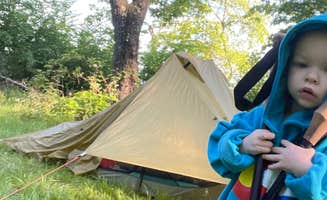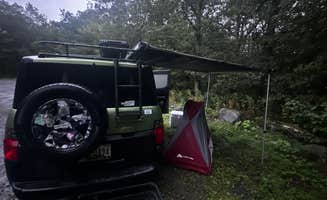Dispersed camping near Bernards, New Jersey primarily exists in nearby wilderness areas rather than within the immediate township boundaries. Primitive camping options can be found approximately 40-50 miles north along the Appalachian Trail corridor, where limited facilities and specific regulations govern overnight stays. Winter temperatures in this region can drop below freezing, with summer highs averaging in the mid-80s Fahrenheit, creating distinctly different camping experiences by season.
What to do
Wildlife observation opportunities: The trail systems connected to Appalachian Trail- Designated Backpacker Campsite 2 provide opportunities for spotting native wildlife. "I gave the site only four stars because there's no water nearby, and the views are only mediocre. Also it's a little on the small and sloped side for tent camping, but I was in a hammock and it was a great place for that!" notes camper Renee Z.
Long-distance hiking routes: Multiple trail networks connect to dispersed camping areas, creating options for multi-day hikes. At Thunder Swamp Trailhead, one visitor reports "Trailhead parking was chill for a night. No trouble. Tons of hiking. Went down Saw Creek trail to a marsh."
Photography at Sunfish Pond: This glacial lake near the Appalachian Trail campsite offers scenic views approximately a half-mile hike from the camping area. The pond's open waters contrast with surrounding forested areas, providing varied photographic subjects throughout different seasons.
What campers like
Hammock-friendly terrain: The tree coverage at dispersed sites provides good hammocking options. Katharine T. reports about her stay at Appalachian Trail campsite: "We stayed here during our section hike through the DWG on the AT. There's plenty of space. We camped nearer to others but there are secluded spots too. We'll maintained w bear boxes provided. Good trees for hammocking."
Social options with privacy alternatives: The layout of some sites permits either community camping or more secluded experiences based on preference. Campers appreciate the flexibility to choose their social experience level rather than being forced into proximity with others.
Bear protection infrastructure: The presence of bear boxes at the Appalachian Trail site provides security for food storage. This reduces wildlife encounters while eliminating the need to bring specialized bear-resistant containers when backpacking to these locations.
What you should know
Water source planning required: No potable water exists at dispersed sites, requiring careful planning. According to reviews of Floyd Bennett Field, all camping supplies including water must be packed in and waste packed out, consistent with Leave No Trace principles.
Seasonal access variations: Winter conditions can make accessing these areas significantly more difficult, with snow and ice affecting both driving routes and hiking trails. Spring brings muddy conditions that can persist until late May depending on rainfall amounts.
Simple overnight parking options: For those seeking minimal accommodations, some trailheads serve basic overnight needs. As benjamin H. describes Thunder Swamp Trailhead: "It's a gravel parking lot. Plenty of shade. No one bothered me."
Tips for camping with families
Pack light but complete: When bringing children to these primitive sites, focus on essential gear only. The hike-in nature of the Appalachian Trail site requires that all supplies be carried, making efficient packing crucial for family groups.
Consider hammock setups for kids: The sloped terrain at some sites makes hammock sleeping potentially more comfortable than tent platforms for children. This setup also adds an element of novelty that may increase children's enthusiasm for the primitive camping experience.
Plan shorter hikes from basecamp: Using dispersed camping areas as a hub, arrange day hikes appropriate for children's stamina levels rather than attempting longer through-hikes with full packs.
Tips from RVers
Limited dispersed options for vehicles: The Bernards area offers minimal true dispersed camping for recreational vehicles. Most sites require either hike-in access or provide only parking-lot style accommodations without hookups or designated camping spaces.
Prepare for self-contained operation: Any RV camping near the Bernards region requires complete self-sufficiency with no dumping stations, water sources, or electrical connections available at primitive sites.
Consider established campgrounds as alternatives: Given the limitations of dispersed options, RV travelers may find conventional campgrounds more suitable despite higher costs and less isolation from other campers.



